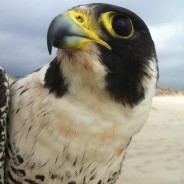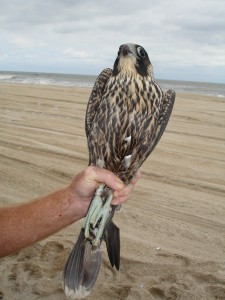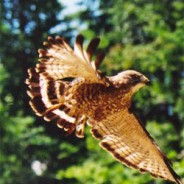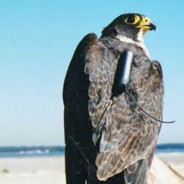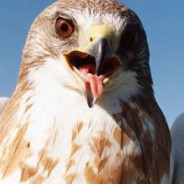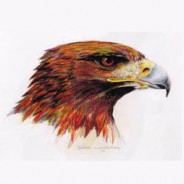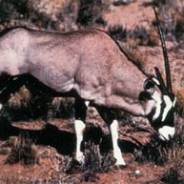Earthspan biologists conduct many important projects in addition to their landmark peregrine falcon research.
Highly Pathogenic Avian Influenza Studies
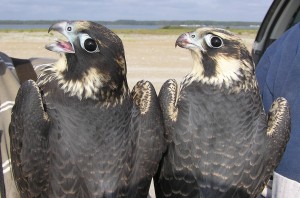 We began a collaboration in December 2022 with Arnaud Van Wettere (DVM, MS, PhD, DACVP)
We began a collaboration in December 2022 with Arnaud Van Wettere (DVM, MS, PhD, DACVP)
at the School of Veterinary Medicine, Utah State University. Entitled Prevalence of Avian Influenza A Virus Antibodies in Migrating North American Peregrine Falcons, it is summarized thus:
An outbreak of highly pathogenic avian influenza (HPAI) virus H5N1 started in the fall of 2021. The scale of this outbreak is unprecedented; it is the largest and most prolonged to date in the USA. Raptors are known to be particularly susceptible to HPAI, with most succumbing within a few days post infection. Given that Peregrine Falcons often prey on bird species known to carry the virus asymptomatically (e.g., waterfowl, gulls, shorebirds), they are at a higher risk of exposure to the virus than most raptor species. While a small number of wild Peregrine Falcons and falconry birds that succumbed to HPAI virus infection have been found during this outbreak, data on how many falcons survive infection is lacking. Studies during past outbreaks have shown that very few falcons (<0.1%) have antibodies to avian influenza virus. However, past HPAI outbreaks occurred in the fall and/or winter and disappeared in early summer with the return of warm temperatures. Therefore, exposure to the virus of Peregrine Falcons that migrate to Central and South America for the winter was likely limited. As this outbreak started in the fall of 2021 but persisted during the summer and fall 2022, Peregrine Falcons are more likely to have been exposed to HPAI virus than in past outbreaks. The goal of this study is to detect evidence of exposure to avian influenza virus. The presence of antibodies to avian influenza virus will be evaluated in the plasma of Peregrine Falcons captured during the fall and spring of 2021-2022 and the spring of 2023 to determine how many Peregrine Falcons have developed an immune response against the virus. Determining the prevalence of antibodies against avian influenza virus will provide documentation of exposure to the virus in migrant Peregrine Falcons and indicate whether some falcons survived infection.
We tested 442 peregrine samples and 6 were positive for influenza A antibodies. For spring and fall 2021 which is the period before the HPAI outbreak started, the combined number of positives is 1 out of 237 birds (0.42%, similar to past studies). For Spring 2022, Fall 2022, and Spring 2023 (the outbreak period) the combined number of positive birds is 4/204 (1.96%). A single individual sampled in both 2021 and 2022 accounted for two of the positives, so was removed from the 2022-23 results. The number of birds with antibodies remains very low, but higher than reported in past surveys. The percentage of peregrines with antibodies in past studies in the US was 1/472 (0.2%) in 2006 to 2010, and 2/299 (0.67%) in 2001 to 2004, and 2 of 109 falcons (1.83%) during the large outbreak of 2014 to 2015. The encouraging news is that AI exposure is not invariably fatal to peregrines, although most succumb rapidly. We also infer that serology metrics in peregrines do relate to the scale of outbreaks, which has grown considerably at present.
53 Years of Peregrine Falcon Studies
Earthspan principals conduct long-term studies on migrating tundra Peregrine Falcons (Falco peregrinus tundrius) at Assateague Island, MD/VA (autumn since 1970) and Padre Island, TX (autumn and spring since autumn 1977). In 2019 we entered into a partnership with The Peregrine Fund to continue these studies. We have expended 58,160 man-hours of survey time in observing 74,574 peregrines and capturing 16,702. The tundra peregrine has made a significant recovery and has been removed from the list of endangered species yet continued monitoring of populations is imperative. Because of the continuity and standard method for data collection these surveys have become an essential tool in that effort. Our database at Assateague includes sightings of every other raptor we have observed on the Island since 1970. Some 90% of all observations there have been recorded by three experienced individuals, who have also conducted springtime studies at Padre Island. At Padre a more diverse cast of highly qualified individuals has participated.
Our work in these studies with satellite-received telemetry allows us to continue elucidating previously undescribed aspects of the tundra peregrine’s wintering biology and continental migration and to identify critical habitats. Given available technologies, Assateague and Padre remain ideal laboratories in which to study and address present and future issues of concern to peregrines, other Neotropical migrants, and humans. We increment and maintain an archive of peregrine blood samples numbering thousands that we have used to study genetics, contaminants and emerging pathogens. In recent years we have studied infectious pathogens such as West Nile Virus and Avian Influenza in partnership with U.S. Government entities, and addressed contaminants through studies related to the 2010 Gulf oil spill.
Blood and feather samples collected from peregrines contribute to collaborative mercury monitoring efforts. We began an effort with Utah State University in 2022 to document Avian Influenza exposure in migrant peregrine falcons through the seroprevalence of associated antibodies, and indicate if some individuals survive infection. We tested 442 samples and 6 birds had antibodies. For spring and fall 2021 which is the period before the AI outbreak started, the combined number of positives is 1 out of 179 birds (0.56%, which is similar to past studies). For Spring 2022, Fall 2022, and Spring 2023, the outbreak period, the combined number of positive birds is 4/205 (1.95%). The number of birds with antibodies remains very low, but higher than reported in past surveys. The percentage of peregrines with antibodies in past studies in the US was 1/472 (0.2%) in 2006 to 2010, and 2/299 (0.67%) in 2001 to 2004. The only encouraging news is that AI exposure is not invariably fatal to peregrines, although most succumb rapidly.
In 2008 our database allowed us to provide an Expert Declaration on the Draft Environmental Assessment and Management Plan for Take of Migrant Peregrine Falcons in the United States for Use in Falconry. Among other points, we concluded that the standardized average number of migrating peregrines we observed at Assateague over the preceding 29 years was essentially the same as that seen more than six decades ago (1939-1944), before DDT had serious adverse effects on the reproductive potential of the peregrine in North America. Our work at Assateague and Padre Islands represents the bulk of tundra Peregrine Falcons banded within the continental United States since the establishment of the Bird Banding Laboratory by the Department of the Interior. Furthermore, our overall database constitutes the most significant and longest continuous monitoring study on this falcon in the Americas. Long-term studies such as ours are essential to monitoring the stability of wildlife populations, particularly in light of rapid changes that may occur due to contaminants, infectious diseases, habitat loss, climate change and other factors. By the long-term and standardized nature of our studies, we have established levels of observation in stable populations that will quickly raise future concerns if not achieved over a several year period.
Assateague Survey 2023 – Between 25 September and 18 October, the survey team of Mike Yates and Bill Seegar expended 220 man-hours in the field, recording 149 sightings of peregrines and capturing 36 different individuals. Three of the falcons captured were previously banded. The 149 sightings included 24 observations of individuals previously captured during the survey. We include these other known duplicates in tables and discussion to allow more direct comparisons among our data and those from pre-survey Assateague counts (dating from 1939) and other projects where protocols do not allow identification of duplicates. We also obtained 36 blood samples and 32 cloacal swabs from captured peregrines, along with associated feather samples for current and future collaborative studies.
Sightings per 10 man-hours were the 17th lowest and captures 11th lowest among our 53 survey years, a disappointing continuance of our recent downturn in numbers. A major concern has been that populations are adversely affected by the Highly Pathogenic Avian Influenza (HPAI) outbreak of 2021-23. Counts at our Padre Island (TX) survey have sharply declined, particularly in spring, and a long-term survey on Alaska’s Yukon River has also shown a concurrent decrease. We know that HPAI is almost invariably fatal to peregrines that become exposed. We looked at raptor counts from other East Coast sites for perspective on our results. North of us is Cape May, NJ and south of us are Kiptopeke, VA and FL Keys. Although those fixed sites with vast viewscapes record more peregrines on favorable migration days and our most productive days are those that retard migration or reduce flight altitudes through wind and/or precipitation, it can be instructive to compare peregrine observations temporally and collectively. Their 2023 results provide little insight on our anemic numbers at Assateague, but they are somewhat reassuring.in terms of any nosedive in migratory tundra peregrine numbers. While Cape May’s seasonal observations slightly declined, healthy increases in observations at Kiptopeke and FL Keys were recorded.
The 2023 migration at Assateague was atypical as a whole, with a predominance of the north winds that assist peregrines in migrating rather than resting on the Assateague beachfront. A review of archived weather data from the Ocean City airport confirmed that anecdotal impression. Of our 24 Survey days, only three had winds with no northerly component, and only four had winds with any of the southerly component that tends to retard migration and make falcons more available for capture. In addition, several days boasted northerly winds in the 19-27 MPH range. Peregrines put many miles behind them and are reluctant to stop on such days, and the techniques necessary to safely capture them are generally futile.
One possible factor in reduced peregrine and other raptor observations at Assateague has been evolving over time, with implications that threaten the island’s long-term status as a magnet for southward migrating tundra peregrines. As the mid-Atlantic coastline to the north has been incrementally developed, there are progressively fewer places a migrant can rest and feed. With little appropriate habitat, many individuals may either divert offshore or inland to bypass development and not return to the coast by the time they pass Assateague. For those in a position to utilize the island, the intense visitation and public use of beachfront habitats are a deterrent. Once extensive sand levels created by frequent ocean washover (Fox Hill and Little Fox Levels in Maryland, Wash Flats in Virginia) were lost through anthropogenic management, and the beachfront became key to peregrine use during migration. Public use of the Seashore beach is intense on many days, and on some weekends in fall we can count over 100 OSVs traversing the beach. Under such conditions, migrants attempting to use the beachfront are soon displaced. Migration patterns could also be changing in response to beachfront development and use. It is interesting to note that in 2023 Cape May hawkwatch and Assateague (coastal) numbers declined, while Kiptopeke (interior bayshore) and FL Keys hawkwatches (converged coastal and interior migrants) increased. Could a larger proportion of migrants be bypassing the traditional coastal route?
The dramatic increase in presence of Bald Eagles (Haliaeetus leucocephalus) we have been observing over the past couple of decades is also demonstrably affecting survey results. In 2019 we observed many more Bald Eagles (364) than peregrines (135), a 210% increase in eagle observations over 2017. This year our 213 sightings exceeded those of peregrines by a 1.43:1 ratio. In earlier survey years eagles encountered were shy and usually gave us a wide berth. Now many are so habituated to human proximity as to display no concern when we pass within 20 meters. They are tame and aggressive; we regularly observe them teaming to rob Ospreys (Pandion haliaetus) of prey, and sometimes observe them in pursuit of peregrines with or without prey. They interfere in our capture attempts, we must always be mindful of their actual or potential presence, and it is likely that such presence also reduces the number of peregrines utilizing the immediate area. 2023 Asstg Rept
Padre Surveys 2023 – During the spring migration period, Yates, Seegar and Doney surveyed the South Padre Island Unit of Laguna Atascosa National Wildlife Refuge from 09 April through 03 May, conducting 261 survey hours in the field over 25 survey days. We recorded 268 peregrine falcon observations and captured 29 peregrines, including 5 seasonal recaptures. Among the new captures, 20 (83.33%) peregrines were first banded this season and 4 (16.67%) were previously banded Padre Returns from the 2012-2022 surveys. Adult peregrines comprised 84% of age-determined sightings (n=191) and 71% of new captures. The minimum average area stopover duration among recaptures was 3 days, ranging from a few hours to 5 days. Our seasonal sighting rate of 10.08 (or-10.27 w/ recaps) new peregrine observations per 10 survey hours is low among recent years, and very close to the lower bounds of our 44-year mean of 15.96 (STD 6.31).
During the fall migration, Gregg Doney’s team conducted 479 survey hours in the field over 31 days, from 25 September through 26 October. We recorded 545 peregrine falcon sightings on South Padre Island and captured 137 peregrines, including 71 seasonal re-sightings and 17 recaptures. Among new captures, 118 (98%) peregrines were first banded this season and 2 (2%) were previously banded Padre Returns, marked during the 2022-2023 migrations. Adults comprised 23% of age-determined sightings (n=413) and 7 % of new captures. The minimum average stopover duration of seasonal recaptures during the fall season is 4 days, ranging from ~15 minutes to 9 days. Our seasonal sighting rate of new peregrine sightings per 10 survey hours is 9.89 (11.38 w/ resight-recaps), low among recent years and below the lower bounds of our 46-year fall Survey mean of 15.71 (STD 5.56). Padre Report 2023
Analysis of Mercury in Migrating Peregrines Published
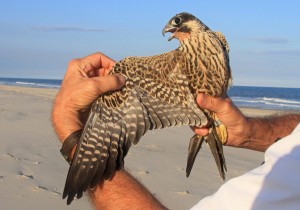 With collaborators Joe Barnes of the Nevada Department of Wildlife and Shawn Gerstenberger of The University of Nevada at Las Vegas we have published our most recent assessment of mercury in feathers we collected 2009-2015 from migrating peregrines at Assateague (MD) and South Padre (TX) Islands. We detected mercury in all sampled fourth primary (range = 0.44–37.46 lg/g) and axillary feathers (range = 0.09–62.68 lg/g). The concentration associated with toxic effects in peregrines is unknown; however, peregrines have recently experienced broad population expansion across the presumed breeding area (northern latitudes of North America) of the birds we sampled. The mercury concentrations we measured were lower than those in an apparently healthy breeding population in the southwestern USA. The literature citation follows, and a PDF is available in Publications, under the About Us tab.
With collaborators Joe Barnes of the Nevada Department of Wildlife and Shawn Gerstenberger of The University of Nevada at Las Vegas we have published our most recent assessment of mercury in feathers we collected 2009-2015 from migrating peregrines at Assateague (MD) and South Padre (TX) Islands. We detected mercury in all sampled fourth primary (range = 0.44–37.46 lg/g) and axillary feathers (range = 0.09–62.68 lg/g). The concentration associated with toxic effects in peregrines is unknown; however, peregrines have recently experienced broad population expansion across the presumed breeding area (northern latitudes of North America) of the birds we sampled. The mercury concentrations we measured were lower than those in an apparently healthy breeding population in the southwestern USA. The literature citation follows, and a PDF is available in Publications, under the About Us tab.
Barnes, J.G., G.E. Doney, M.A. Yates, W.S. Seegar, and S.L. Gerstenberger. 2019. A Broadscale Assessment of Mercury Contamination in Peregrine Falcons Across the Northern Latitudes of North America. J. Raptor Res. 53(1):1-13.
Polycyclic Aromatic Hydrocarbon Monitoring in Migratory Peregrines
The Deepwater Horizon Oil Spill (DWH) released an estimated 5 million barrels of oil into the Gulf of Mexico during April through July 2010. Earthspan and its partners, The Peregrine Fund and the University of Connecticut, collected and analyzed blood samples from migrating Peregrine Falcons (more…)
Wintering area DDE source to migratory white-faced ibis revealed by satellite telemetry and prey sampling
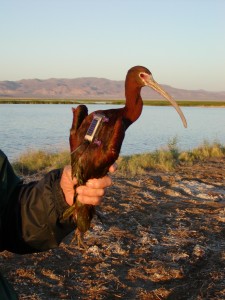
White-faced ibis with PTT package
Earthspan principals led a cooperative study to identify the source(s) of DDT-related contamination still plaguing a northern Nevada population of white-faced ibis many years after use of the pesticide was banned in the United States. (more…)
Broad-winged hawk: Movements and habitat association during migration and wintering periods
Problem/Background
Modern organophosphate insecticides are short-lived in the environment. These insecticides are toxic to raptors, but they are unlikely to be detected in animal blood or tissue unless the animals are sampled soon after exposure. Researchers postulate that pesticide exposures, and habitat alteration, in their wintering (more…)
Summary of Final Report: Study of Peregrine Falcons Wintering on the Gulf Coast of Mexico
Abstract
Fundación Ara and Earthspan conducted a study of peregrine falcons (Falco peregrinus) wintering on the Gulf coast of Mexico. Data collection occurred between January 1997 and October 1998. The main aim of the study was to better understand the movements of peregrine falcons on their wintering grounds. Other objectives were to track peregrines to their breeding areas (more…)
Swainson’s Hawk: Scientific Research Rescues Species Before Threatened or Endangered Status Listing is Needed
Problem/Background
The Swainson’s Hawk (Buteo swainsonii, SWHA) is listed as a species of concern by five states and the Bureau of Land Management, and as a special emphasis species by the U.S. Forest Service. Nesting population declines was reported over much of the SWHA range in the early 1990s. With no obvious reason for this decline, (more…)
A Study of The Golden Eagle in Mexico
Selected Passages from the Final Report to Proyecto ARA A.C.
Introduction
Mexico’s national bird, the golden eagle (Aquila chrysaetos), is classified as “in danger” in Article 9 of the Federal Hunting Law (SEDUE 1984) and Ramos (1986) classifies the population as declining, primarily due to decreases in habitat quality. Environmental pollution (more…)
Satellite Tracking Oryx
Accomplishments
White Sands Missile Range, New Mexico
White Sands Missile Range (WSMR) is the military’s largest all-overland test range in the Western Hemisphere and encompasses 2.2 million acres, which can be extended to 4 million acres (total) by including adjacent federal land holdings. WSMR houses the U.S. Army Research, Development, Test, and Evaluation (more…)

